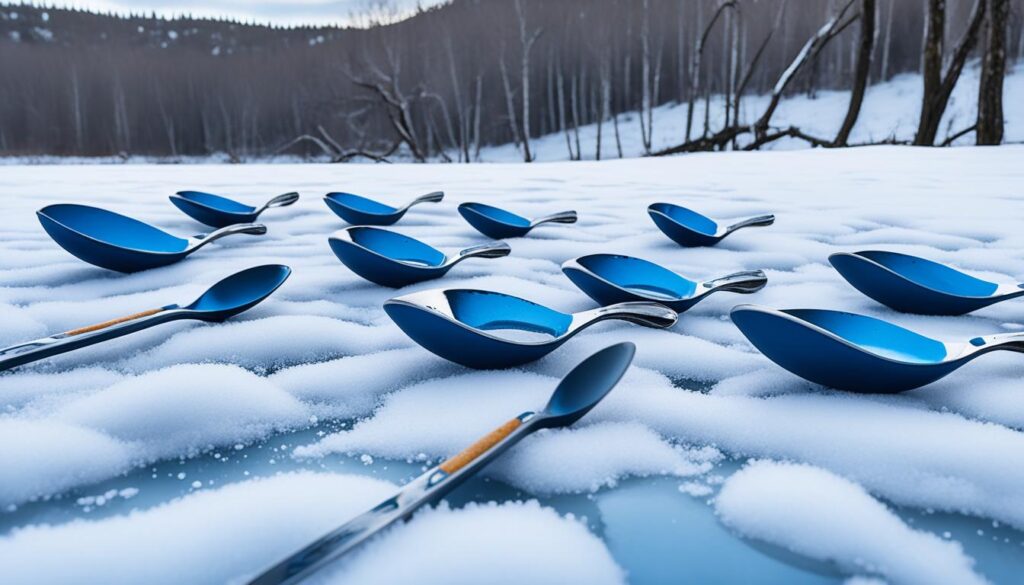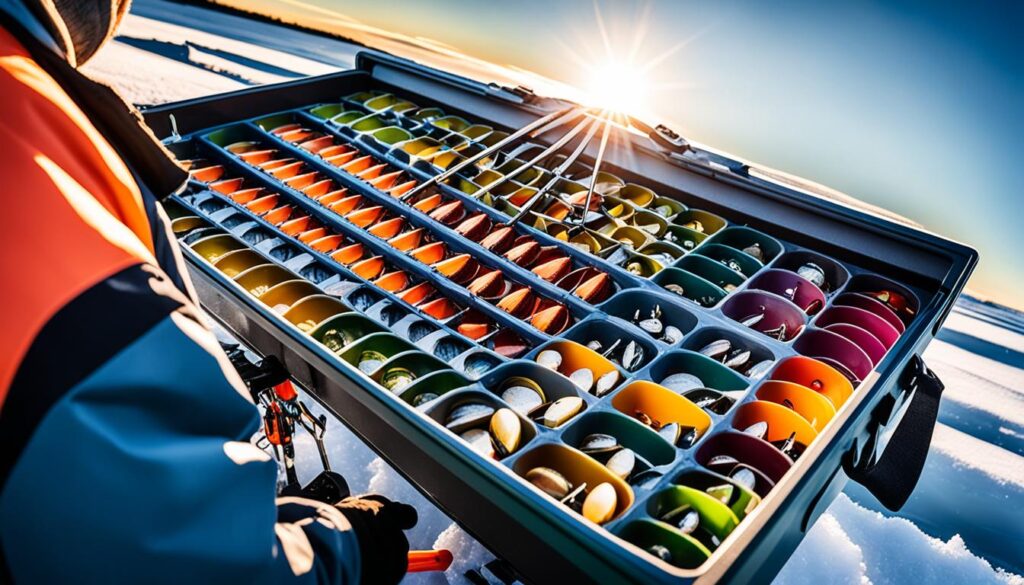For avid bass anglers, early winter challenges catching these elusive fish. As temperatures drop and bass move to deeper waters, having effective techniques and gear becomes crucial. A standout method for this season is using jigging spoons.
Jigging spoons are versatile lures mimicking baitfish movement, a critical food source for winter bass. Their design allows fishing at various depths, which is ideal for bass transitioning from deep reservoirs to shallower areas like creek arms and coves.
When using jigging spoons, employ a popping motion to provoke a reaction strike. Drop the spoon to 15-40 feet depth and pop it for stubborn bass bites.
To maximize success, choose the right spoon for depth and bass preferences. Effective presentation techniques and proper gear are also vital for landing trophy-sized bass.
- Jigging spoons are effective lures for targeting bass in early winter.
- They mimic the movement and profile of baitfish, a primary food source for bass.
- Jigging spoons can target bass transitioning from deep reservoirs to shallower areas.
- The popping motion of the spoon creates a reaction strike from the bass.
- Choosing the right jigging spoon and using effective presentation techniques are crucial to success in early winter bass fishing.
Benefits of Early Winter Bass Fishing with Jigging Spoons
Jigging spoons offer several advantages in early winter bass fishing. These versatile lures effectively mimic the profile of baitfish, a primary food source for bass during this season. Their realistic baitfish profile and match-the-hatch appeal make them irresistible to bass, provoking a reaction strike.
The weight and design of jigging spoons create a unique and elusive action that mimics injured or fleeing baitfish, further enticing bass. This erratic movement triggers the predator instinct in the bass, increasing the likelihood of an attack.
Using jigging spoons in early winter allows anglers to target bass transitioning from deep reservoirs to shallower areas like creek arms and coves. As temperatures drop, bass move towards warmer water and forage, and jigging spoons can effectively reach depths ranging from 15 to 40 feet, successfully hooking this transitioning bass in deep reservoirs.
Jigging spoons allow anglers to catch more fish while providing a versatile and dynamic fishing experience. Their adaptability allows for various presentations, including vertical jigging, casting, retrieving, or trolling.
In summary, jigging spoons excel in imitating the natural movements of baitfish, making them essential tools for anglers targeting bass during early winter. Their versatility, match-the-hatch appeal, and ability to trigger reaction strikes make them additions to every angler’s tackle box.
| Benefits of Jigging Spoons for Early Winter Bass Fishing | Description |
|---|---|
| Imitates Baitfish Profile | Jigging spoons effectively mimic the profile of baitfish, the primary food source for bass during early winter. |
| Elusive Action | The unique design and weight of jigging spoons provide an elusive action that entices bass to strike. |
| Target Transitioning Bass | Jigging spoons allow anglers to target bass that are transitioning from deep reservoirs to shallower areas. |
| Versatile Presentation Options | Jigging spoons can be used in various presentations, including vertical jigging, casting and retrieving, and trolling. |
| Trigger Reaction Strikes | The irresistible jigging spoon action triggers the predator instinct in bass, leading to reaction strikes. |

Choosing the Right Jigging Spoon for Early Winter Bass Fishing
Selecting the perfect jigging spoon is crucial for early winter bass fishing success. Consider these factors to maximize your chances of enticing bass:
Weight: Opt for a slab spoon weighing around 7/8 ounces to reach desired depths where bass may be holding.
Design: Look for spoons with a realistic baitfish profile and elusive action to trigger reaction strikes from bass.
Bait Specs: Pay attention to size, color, and finish to match the hatch effectively and increase your success rate.
Treble Hook: Ensure the spoon has a sharp, durable treble hook for secure hooksets on striking bass.
Stinger Hook: Attach a stinger hook to increase hooking opportunities, especially when bass are striking short.
Effective Presentation Techniques for Jigging Spoons in Early Winter Bass Fishing
Mastering presentation techniques is critical to success when using jigging spoons for early winter bass fishing. Adapt your approach based on bass depth for optimal results:
Flipping and Free Spool Technique:
- When bass are suspended, employ a flipping and free spool technique.
- Drop the spoon to the desired depths, then release the line to let it fall naturally.
- If a strike occurs, halt the spool to ensure a solid hookset.
Double-Pump Cadence: For bass near the bottom, utilize a double-pump cadence. Lift the spoon off the bottom with a quick upward motion, then let it fall back, mimicking injured baitfish. Repeat this motion to entice bass hiding in bottom structures.
Optimal Gear and Equipment: Select appropriate gear, such as a 6-foot 6-inch medium-heavy bait caster paired with forward-facing sonar. This setup offers the power to handle larger fish and enables precise control in tight spaces, which is ideal for targeting bass with jigging spoons.
Targeting Sunlit Dock Stalls: Focus on sunlit dock stalls, where warmth attracts baitfish and bass. Cast near pilings and dock edges, presenting the spoon to bass hiding in these structures for an easy meal.

The Effectiveness of Jigging Spoons in Cold Water Bass Fishing
Jigging spoons excel in cold water bass fishing, particularly during winter when bass are less active. Here’s why they’re so effective:
Shad Imitations: Jigging spoons mimic winter-chilled shad, a preferred cold-water bass food source.
Precise Placement: Their weight allows accurate casting to deeper areas where bass seeks stable temperatures.
Natural Presentation: The fluttering action resembles injured baitfish, triggering bass strikes even in lethargic fish.
Speed and Cadence: Slow, subtle retrieves imitate the movement of chilled shad, enticing bass to strike.
Targeting Structure: Focus on deepwater areas near structures like rocks and drop-offs, where bass lurk as ambush predators.
Sonar Use: Utilize fishfinders to locate baitfish schools, adjusting spoon presentation based on depth for optimal results.
In conclusion, jigging spoons are a go-to choice for anglers targeting bass in cold water. They offer a realistic presentation and precise targeting that can lead to successful winter fishing outings.
“Jigging spoons are like a magnet for lethargic bass in cold water. Their lifelike action and shad imitations make them irresistible to bass, conserving energy in the chilly conditions.”
Techniques for Fishing Jigging Spoons in Cold Water
Mastering the art of fishing and jigging spoons in cold water can significantly boost your catch rates. Here are three effective techniques to try:
1. Vertical Jigging: Drop the spoon directly before the fish, varying your jigging cadence to mimic dying baitfish. Experiment with different motions to trigger reaction strikes.
2. Bottom Structure: Target creek and river channels, where bass and other species seek shelter. Work the spoon along the bottom, adjusting your presentation based on water depth.
3. Bridges: Fish near bridge pilings, focusing on areas with strong current flow. Work the spoon around eddies and slack water pockets to entice strikes from fish seeking refuge.
Please adapt your techniques to the conditions and fish behavior for the best results. With patience and experimentation, you can master the art of fishing, jigging spoons in cold water, and land that trophy fish.
Gear Recommendations for Jigging Spoons in Cold Water Bass Fishing
Selecting the right gear is crucial for optimizing your jigging spoon fishing experience. Here are some gear recommendations to consider:
1. Spinning or Baitcasting Gear: Choose spinning gear for lighter jigging spoons and finesse control. Opt for baitcasting gear for heavier spoons and increased power and control.
2. Fishing Line: Consider a fluorocarbon line for low visibility in clear water or a braided line for enhanced strength and sensitivity. Match the line weight to the size of the jigging spoon and the depth you’ll be fishing.
Consider a medium-heavy fishing rod around 7 feet long for the best results. This versatile rod is an ideal match for effective jigging, capable of handling the weight of the jigging spoon and providing enough backbone for hooksets. It’s a reliable choice that instills confidence in your gear selection.
4. Reel: Choose a reel with a high gear ratio for quick retrieves and better control over the jigging motion. Look for features like smooth drag systems and durable construction to handle the demands of cold-water bass fishing.
By selecting the right gear for your jigging spoon fishing setup, you can maximize your chances of success and enjoy a more rewarding fishing experience in cold water conditions.

Effective Presentations for Jigging Spoons in Cold Water Bass Fishing
Mastering presentation techniques is crucial for success when fishing with jigging spoons in cold water. Here are some effective methods to entice bass to strike:
1. Drop and Lift Technique: Drop the spoon to the desired depth and lift it with a quick upward motion to imitate an injured baitfish fluttering down. This action triggers the predatory instincts of the bass.
2. Bottom Bouncing: Drag the spoon along the bottom with slow sweeps of the rod, creating vibrations that mimic the movement of wounded baitfish. This technique attracts bass and encourages them to strike.
3. Dragging Through Cover: Slowly work the spoon through areas with cover, such as standing timber or brush piles, to mimic the movements of prey fish seeking refuge. This technique can entice reluctant bass to hide in cover to strike.
4. Slow Sweeps: Use slow sweeps of the rod to impart a subtle and enticing action to the spoon. This slow movement can tempt cautious bass into biting, even in low-temperature conditions.
5. Targeting Grass Edges: Fish lighter spoons with short hops along the tops of tapering grass edges. The subtle movements imitate prey fish navigating through the grass, triggering bass to strike.
Experiment with these presentation techniques and adjust your approach based on the behavior of the bass and specific fishing conditions. With practice, you’ll increase your chances of success when fishing with jigging spoons in cold water.
Conclusion
Jigging spoons are a highly effective technique for early winter bass fishing, offering anglers a chance to land trophy-sized catches. By employing the right gear and presentation strategies, anglers can significantly increase their success during this transitional season.
When choosing gear, opt for a slab spoon weighing 7/8 ounces to reach the desired depths where the bass may be positioned. Consider the spoon’s color, and attach a stinger hook for improved hooking opportunities.
Adapt presentation techniques based on bass depth. Use flipping and free spooling for suspended fish, double-pump cadence for bass closer to the bottom, and target sunlit dock stalls. Adjust rod and reel setups accordingly, with spinning gear and fluorocarbon line preferred for lighter jigs and baitcasting gear with braided line suitable for heavier spoons.
Mastering the art of jigging spoons requires practice, experimentation, and adaptability. Early winter bass fishing can be enjoyable and rewarding with these techniques, leading to impressive catches.
FAQ
What makes jigging spoons effective for early winter bass fishing?
Jigging spoons imitate the profile of baitfish and provide an elusive action that entices bass to strike. They can be used to target bass transitioning from deep reservoirs to shallow areas. The weight and design of the spoon make it desirable to bass, leading to reaction strikes.
How do I choose the right jigging spoon for early winter bass fishing?
Consider the weight and design of the spoon based on the depth you’re targeting. A 7/8 ounce slab spoon is often preferred. Popular colors include white, coleslaw, bloodline, and Table Rock shad. It’s also recommended to attach a stinger hook to increase hooking opportunities.
What are some presentation techniques for jigging spoons in early winter?
For suspended fish, use a flipping and free spooling technique. For bass closer to the bottom, a double-pump cadence can be effective. Use a 6-foot 6-inch medium-heavy baitcaster with forward-facing sonar. Also, target dock stalls in the sun for increased success.
Why are jigging spoons effective in cold water bass fishing?
In cold water, bass become lethargic. Jigging spoons can entice these sluggish bass with their shad imitations and precise placement. The weight and action of the spoon provide a realistic presentation that resembles winter-chilled shad, a preferred food source for bass.
What techniques can I use for fishing jigging spoons in cold water?
Vertical jigging is popular, dropping the spoon and using controlled slack lines to mimic dying baitfish. Fishing along bottom structures like creek channels and river channels where bass transition to deeper water is effective. Bridges also provide ambush opportunities.
What gear should I use for jigging spoons in cold water bass fishing?
Spinning gear with fluorocarbon line is recommended for lighter spoons, while baitcasting gear with heavier spoons provides more control. Use a medium-heavy fishing rod with a length of 7 feet and a high gear ratio reel.
What are effective presentations for jigging spoons in cold water bass fishing?
Drop and lift techniques create a fluttering action. Bottom bouncing involves dragging the spoon along the bottom with slow sweeps of the rod. Dragging the spoon through cover, like standing timber, can entice reluctant bass to strike. For grassy areas, a lighter spoon can be used with short hops along grass edges.
What are the benefits of vertically jigging spoons in early winter bass fishing?
Vertically jigging spoons allow for precise placement and can effectively imitate winter-chilled shad, a preferred food source for bass. This technique helps locate bass by first locating shad and increases the chances of success, especially during inactive or tough fishing days.
What gear and presentation techniques should I use for vertically jigging spoons in early winter bass fishing?
For lighter spoons, use spinning gear with fluorocarbon line. Baitcasting gear with heavier spoons provides more control. Use a fishing rod with the appropriate length and action for controlled slack lines. Experiment with different techniques like the drop and lift technique and subtle presentations.
How effective are jigging spoons for early winter bass fishing?
Jigging spoons are a proven and effective technique for early winter bass fishing. They, along with the recommended gear and presentation strategies, can greatly increase the chances of success when targeting bass during this transitional season.
